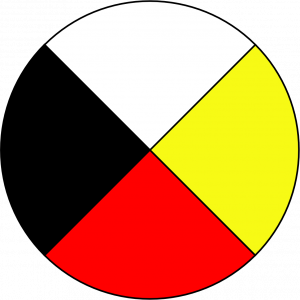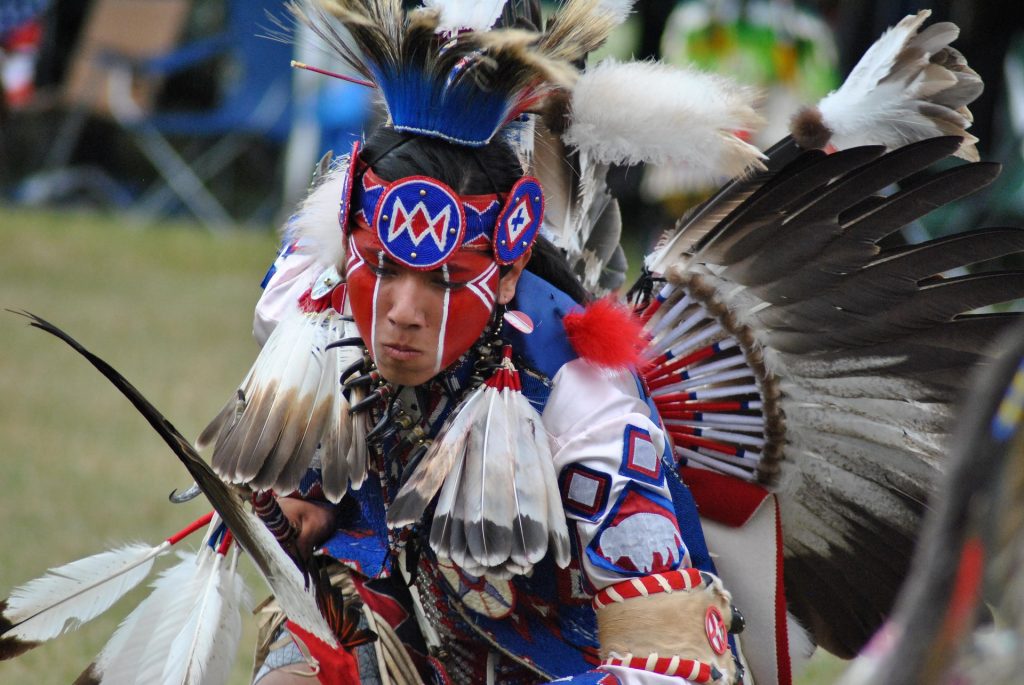5.2: The Importance of Indigenous Foundations
Storytelling and Oral Tradition
“As the young asked, the old men and the old women thought about these matters. They gave their answers and explanations in the form of stories, songs, prayers, rituals and ceremonies.”
– Basil Johnston, 1976
Traditionally, Ojibway Elders often provided lessons and demonstrated expected behaviour through stories told in lodges during activities such as repairing fishing nets or hunting equipment, and when clothing and food were being prepared. Characters in the stories, including animals or other creatures in the natural world, often possessed spirits and needed to be passed along with accuracy, respect and sometimes permission to reshare with others. Listeners are often expected to come to their own interpretations and understandings, rather than views being imposed.
Stories are a pedagogical tool whereby meaning can be expressed, renegotiated, interpreted, or shared with learners. Stories help educators and learners make connections between complex issues and can be used as either primary or supplemental instructional materials. Accompanying stories with a hands-on activity approach, for example, models a traditional way of teaching used with many Indigenous peoples, and relates to the principles of UDL by providing an alternative way for students to engage in learning, and a different representation from typical written content.
In Indigenous cultures, stories are usually told by Elders or Knowledge Keepers who decide when a learner is ready for the knowledge. It is important not to assume that because a story has been shared with you, that it is appropriate for you to share it with others. It is wise to speak with members of the community or the Elders represented to know for sure (Archibald, n.d.) whether you can share the story in your own teaching. JoAnne Archibald suggests seven principles of Indigenous story work including “respect, responsibility, reverence, reciprocity, inter-relatedness, holism, and synergy” (Archibald, 2019).
We have tried to model elements of storytelling throughout this module. We encourage you to research and learn more about Indigenous Peoples stories from the nations in your local area, and your institutional Indigenous centre or advisory council, or Indigenous curriculum supports if you have them. These voices will be best positioned to advise how you can (or can’t) use Indigenous stories in your teaching practices.
Medicine Wheel
The cycle of life through many dimensions can be captured and symbolized through the medicine wheel. Historically, medicine wheels may have taken the form of a stone circle with vertical and horizontal lines bisecting in the middle (Kemppainen et al., 2008).
A more recent rendition involves colouring of the quadrants and the colours may vary based on the community it represents. You might be familiar with one common presentation of the Medicine Wheel where the four quadrants are shown with white in the north quadrant, yellow in the east quadrant, red in the south quadrant, and black in the west quadrant. The centre is the intersection point that represents the individual balanced between these quadrants.

Talking or sharing circles are often used in Indigenous teaching and learning environments. Circles have traditionally been used to demonstrate that everyone is connected and that every person in the circle has an equal voice. They also ensure that everyone can see and hear the speaker, and turn-taking is important. It is a considerably different model to the traditional classroom with the instructor at the front with rows upon rows of students facing forward. The power differential is very different between these two learning environments as well, with the circle approach having parallels to Universal Design principles (can you think of which ones?) You may want to consider how you can include the circle approach in your teaching and what impact that might have on all your learners.
There are many, many teachings using the medicine wheel, and some are described in the Four Directions Teachings![]() interactive video website if you wish to learn more about the use of the Medicine Wheel in Indigenous pedagogy. The site features versions of the medicine wheel teachings from five Nations perspectives including: Mikmaq, Mohawk, Ojibwe, Cree and Blackfoot. We recommend you take some time to familiarise yourself with these resources and learnings and consider the relationship between your own teaching and the teachings shared in this.
interactive video website if you wish to learn more about the use of the Medicine Wheel in Indigenous pedagogy. The site features versions of the medicine wheel teachings from five Nations perspectives including: Mikmaq, Mohawk, Ojibwe, Cree and Blackfoot. We recommend you take some time to familiarise yourself with these resources and learnings and consider the relationship between your own teaching and the teachings shared in this.
Sacred, Secular and Spiritual
Sacred, secular and spiritual connectedness are at the root of Indigenous worldviews, events, and teachings. There are many traditions depending on the nations featured (there are over 600 nations in the land we now call Canada). Indigenous teachings and activities integrate deeper meaning beyond the obvious and connect to ancestors and the surrounding living world.
As post-secondary education in Ontario and across the country slowly starts to incorporate more Indigenous content in their programs, it is important for educators to understand the context of spirituality in Indigenous knowledges and worldviews and how these may be perceived by learners and non-Indigenous colleagues. This can be uncomfortable for many faculty and students who were trained in traditional Western educational settings, but it is critical that we engage respectfully and appropriately with these elements of Indigenous pedagogies. According to Hoffman,
“Aboriginal ontologies and epistemologies are rooted in worldviews that are inclusive of both the sacred and the secular. [In Indigenous ontologies] the world exists in one reality composed of an inseparable weave of secular and sacred dimensions” (2013, p. 190).
Pow Wows are just one example of events with deep interconnectedness involving ceremony, regalia, drums, music, food, dance, and celebration. They are intergenerational, practice spiritual healing and have etiquette and protocols to observe. Pow Wows are hosted across Turtle Island (the land we now call North America).

The Importance of Smudging
Smudging is another practice that involves burning of one or more of the sacred four medicines (sage, cedar, tobacco and sweet grass) while reflecting and engaging in reflective cleansing. Smudging begins by cleansing of the air, then the mind, eyes, ears and mouth to see, hear, and speak well of others. It also involves letting go of the negatives and is part of living a good life and welcomes cleansing of the spirit and emotions (Ontario Federation of Labour, 2019).
The following video, The Importance of Smudging [4:54], has a brief overview of what smudging is and what it means to Jaimie Kechego.
The Learning Spirit
In the book “Aboriginal Learning: A Review of Current Metrics of Success,” Tunison (2007) explores the often-observed academic success gap in Aboriginal learners by identifying a crucial element which he calls the “Learning Spirit”. By redefining what success looks and feels like from the Indigenous learner perspective, post-secondary educators will become knowledgeable in how to support the learning spirit within the student.
The Mt. Elgin Industrial Institute – Indian Residential School Monument, erected in 2012, features seven stone pillars with each pillar containing names of children who attended the residential school. Children attended from all over Ontario and Michigan. Each of the seven pillars correspond to one of the Anishinaabe Seven Grandfather Teachings. Read more about the memorial and its story from The story of the Chippewas of the Thames Indian Residential School Monument![]() webpage.
webpage.
The video below [6:12] contains Jaimie’s story about the monument, the importance of the learning spirit, and how it connects to herself, her family, and the residential school system.
Intergenerational and Relational Learning
Robin Wall Kimmerer in her book, Braiding Sweetgrass, mentions several teachings that have been handed down generation after generation. In her chapter, “Mishkos Kenomagwen: The Teachings of Grass”, she discusses learning from Elder Lena about how to select one of the four sacred medicines – sweetgrass. Lena says,
“It’s our way,” she says, “to take only what we need. I’ve always been told that you never take more than half.” “Our teachings,” she says, “are very strong. They wouldn’t get handed on if they weren’t useful. The most important thing to remember is what my grandmother always said: ‘If we use a plant respectfully it will stay with us and flourish. If we ignore it, it will go away. If you don’t give it respect, it will leave us” (Kimmerer, 2013, p. 157).
This passage is striking as it embodies so many teachings that are passed down through oral history and Indigenous ways. Only the useful ones get passed down and have strength in the community. Relational learning (between humans and between all living beings) and intergenerational learning — that which is passed down between generations is foundational in Indigenous pedagogies.
The following video, The Importance of Relationality and Intergenerational Learning [6:32], explores ways of building strong relationships especially between the generations.
As a post-secondary educator, you may wish to engage Elders or Knowledge Keepers in events or consultations, to help you learn more about Indigenous pedagogies. The Respecting and Working with Elders [6:17] video shares some common-sense respectful approaches to consider in these engagements.
Activity 2: Reflection
Read a children’s book, out loud, and reflect on:
- The points you emphasize
- Why those points are important to you
- Why those points are important to the story
- Why those points may be important to the listener
Using one the stories provided below, do the same activity again:
- Hodinohso:ni Art Lesson #9 – Corn Husk Dolls

- The Ojibway creation story

- Haudenosaunee creation story

What do you notice about how you read these stories? How might storytelling or oral history fit in your course/curriculum? How might oral storytelling form part of a UDL plan for your courses?
You are invited to record your reflection in the way that works best for you, which may include writing, drawing, creating an audio or video file, mind map or any other method that will allow you to document your ideas and refine them at the end of this module.
Alternatively, a text-based note-taking space is provided below. Any notes you take here remain entirely confidential and visible only to you. Use this space as you wish to keep track of your thoughts, learning, and activity responses. Download a text copy of your notes before moving on to the next page of the module to ensure you don’t lose any of your work!
References
Archibald, J., (n.d.). On becoming story ready. Indigenous Storywork. Retrieved Dec 18, 2021 from https://indigenousstorywork.com/1-for-educators/
Archibald, J. (2019). Indigenous storytelling. Indigenous Storywork. (Fall 2019). Retrieved from: https://indigenousstorywork.com/1-for-educators/
Hill, R. & Sky, R., (2012) Deyohahá:ge: Indigenous Knowledge Centre Hodinohso:ni Art Lesson #9 – Corn Husk Dolls. https://snpolytechnic.com/sites/default/files/docs/resource/9_haudenosaunee_arts_dolls.pdf
Johnston, B. (1976). Ojibway heritage: The ceremonies, rituals, songs, dances, prayers and legends of the Ojibway. Toronto, ON, Canada: McClelland & Stewart Inc.
Hoffman, R. (2013). Respecting Aboriginal knowledge in the academy. Alternative: An International Journal of Indigenous Peoples, 9(3), 189-203.
Ontario Federation of Labour. (June, 2019). Guidelines for Indigenous Smudge Ceremony. Retrieved Dec 18, 2021 from https://ofl.ca/wp-content/uploads/2019.06.21-OFL-FNMI-Guidelines-for-Indigenous-Smudge-Ceremony.pdf
Tunison, S. (2007). Aboriginal learning a review of current metrics of success. Aboriginal Learning Knowledge Centre. http://en.copian.ca/library/research/ccl/aboriginal_learning_review/aboriginal_learning_review.pdf
Kemppainen, D., Kopera-Frye, K., & Woodard, J. (2008). The medicine wheel: A versatile tool for promoting positive change in diverse contexts. Collected Essays on Learning and Teaching: The Evolving Scholarship of Teaching and Learning, 1, 80-84.
Littlejohn657 (Author). (2021). Medicine Wheel [Image]. Wikimedia Commons. https://commons.wikimedia.org/wiki/File:Medicine_Wheel.png

